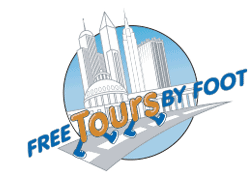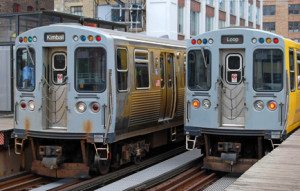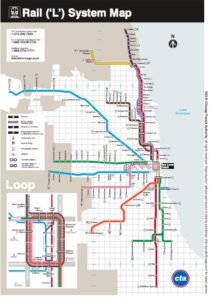Getting around Chicago on public transit is easy for visitors and tourists, and can really save you money as you explore the Windy City.
Our Chicago tour guides have provided thousands of tours in the past few decades, so they are very well-versed in how to get around the city, and we'll be providing some of their suggestions in this post.
We'll also include helpful tips and tricks from members of our Chicago Travel Tips Facebook Group.
- Overview
- Pricing
- CTA Map
- Getting Around by Train
- Getting Around by Bus
- Helpful Apps
- Tips From Locals and Travelers
OVERVIEW
The ‘L’
Chicago residents call their train the ‘L’, not the subway or the tube, or the metra. We call it the L because it is short for “elevated.”
The majority of our train system is elevated above ground which means it is great to ride to enjoy the view of the city.
Taking the ‘L’is really handy especially to get to certain destinations.
You definitely need the ‘L’ to enjoy Frank Lloyd Wright’s famous work (Green Line; Oak Park Stop) or if you are actually a Sox fan and want to cheer for them (Red Line; 35th Stop).
Although some feel there is a risk of crime on the L and other public transportation in Chicago, most of the travelers on our Facebook Group insist it is entirely safe to ride these trains.
Metra Commuter Rails
The high-speed Metra commuter rail service can take you from the downtown area to any of the surrounding suburbs quickly and safely.
For tourists visiting the city, the 495 miles of Metra rail servicing 241 different stations throughout the city can take you to all sorts of attractions Chicago has to offer.
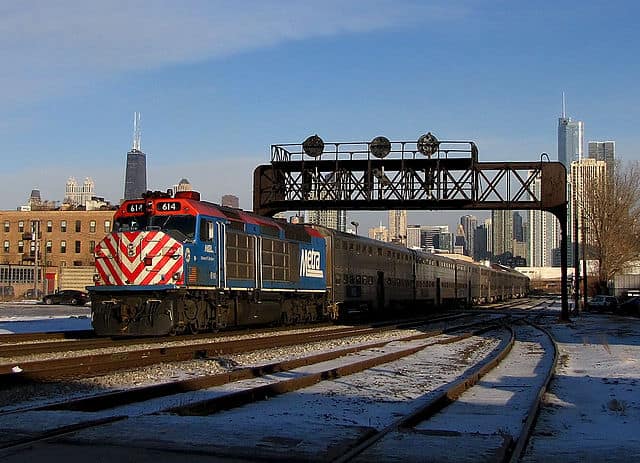
From your seat on the train, you can see the beautiful lakefront, ride past the many museums, zoos, and sporting events, and even stop along the way to take in some of the cultural sites of the city.
All transit (subway trains, CTA trains, buses, Metra Trains) operate through one payment method, called a Ventra Card.
These cards can be purchased at all subway stations for a single ride, or re-loadable pass.
All train stations have a Ventra machine for purchasing these passes located just beside the entrance gates.
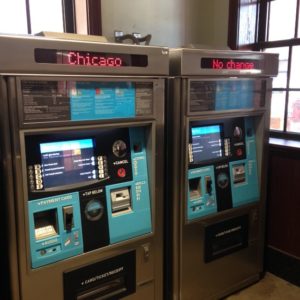
CONTACTLESS PAYMENT
While the Ventra Payment Cards aren't technically contactless, there is one way to pay for the fare which won't require you to make contact with anyone else.
The Ventra App now allows you to pay for digital passes called Metra Mobile Tickets you can use to board trains.
All you need to do is show the ticket on your phone to the conductor when asked.
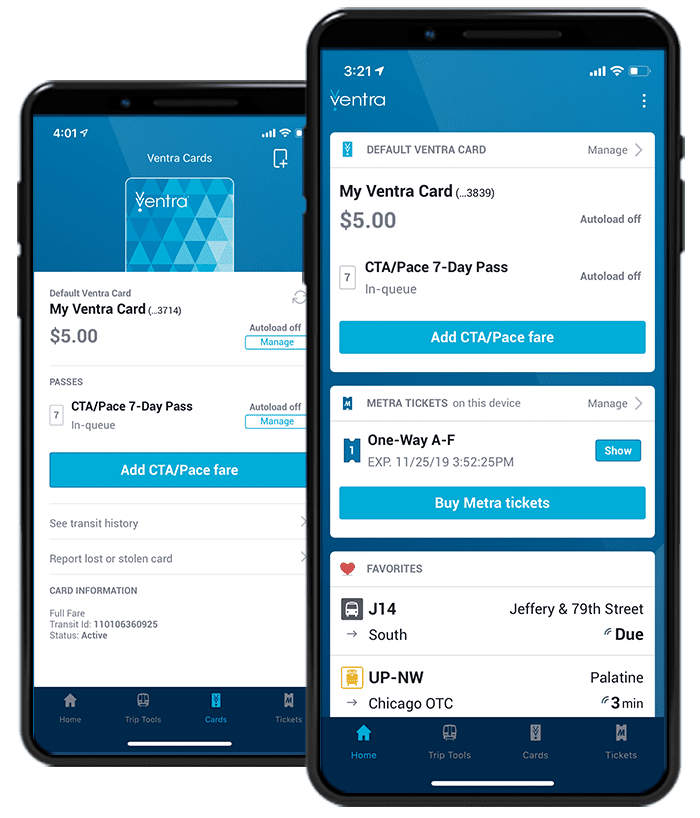
You can also purchase digital Ventra Payment Cards using this app. The conductor won't need to touch your phone, so this method of payment is essentially contactless!
This mobile ticketing option is available on most Android phones, iPhones, and even the Apple Watch.
The Ventra App also includes tools such as up-to-date arrival and departure information and a trip planner.
This is probably the easiest way to purchase tickets or passes for Metra Commuter Rails, and it's also one of the safest options.
The prices listed below are the same on the Ventra App as they are for traditional tickets and passes.
FARES
You have several options when it comes to buying a Ventra Card.
Below are the base fare costs, meaning a one-way, one-time ride. These are also the prices for CTA bus fare.
It’s important to compare a base fare/single ride cost to the cost of the passes, to determine which option is right for you.
Base Fare
- “L” Train: $2.50
- Bus Ride: $2.25
- Transfer (within 2 hours): Free
Passes
- CTA 1 Day Pass | $5
- CTA 3-Day Pass | $15
- CTA 7-Day Pass | $20
- CTA/Pace 7-Day Pass | $25
- CTA/Pace 30-Day Pass | $75
Cash vs Credit: While buses will take cash (exact change needed), in order to ride a train/subway you will need a Ventra ticket.
The Ventra machines are located at all train stations and accept cash or credit card.
Pro Tip: The cost of a reloadable card is $5, but you can register that card to receive $5 free ride credit, which gives you your money back!
CTA MAP
The map can be intimidating, but if we look at it one step at a time, it is actually pretty easy to track:
Click the map to enlarge it.
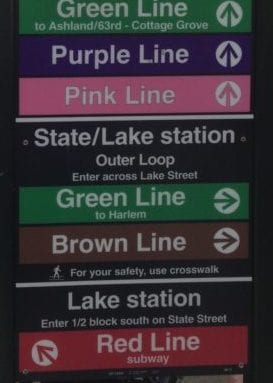
Chicago uses a color-coded Rail (‘L’) train system that operates on street level, underground, and on an elevated track.
Each color track on the map represents a different subway route:
- Red Line
- Blue Line
- Orange Line
- Brown Line
- Pink Line
- Green Line
- Purple Line
- Yellow Line
It’s best to first figure out which of the above lines you are taking, and then look at which stop on that line is closest to your destination.
The Loop
You’ll notice a magnified portion of the map called The Loop.
Trains coming from outside the city enter Downtown Chicago’s “Loop”, and then circle back out to cover the rest of the city in a loop pattern.
This makes it easy and fast to go anywhere in Chicago from hotels to popular attractions from Downtown Loop!
The Loop is the busiest and most exciting part of the city, and we offer a pay-what-you-like Loop Tour all year long!
GETTING AROUND BY TRAIN
The Red Line train is one of the most popular and frequent trains, as it runs north and south through Downtown along the coast.
It stops at the most popular attractions and busiest neighborhoods of Chicago.
The Red Line operates at all times, every day. Here are the stations along this route that service other train lines.
- Howard
- Wilson
- Belmont
- Fullerton
- Lake
- Jackson
- Roosevelt
Most other stations along the red route connect to at least one bus line, but some are only park & rides.
The Blue Line travels West to popular neighborhoods such as Wicker Park/Bucktown, and North to O’Hare Airport.
The Blue Line operates at all times, every day.
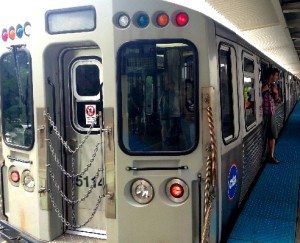
Here are the stations along this route that service other train lines:
- Clark/Lake
- Washington
- Jackson
While there aren't a lot of stations on the route that connect with other trains, every other station serviced by the blue line connects to at least one bus line.
From O’Hare International Airport
The Blue Line arrives/departs from O’Hare Airport and enters “the Loop”, making it the most convenient way to get to your Downtown Hotel without needing to transfer.
We go into more detail in our post titled: How to Get to Downtown Chicago from O'Hare Airport.
From Midway International Airport
The Orange Line arrives/departs from Midway Airport and enters “the Loop”, making it the most convenient way to get to your Downtown Hotel without needing to transfer.
We go into more detail in our post titled: How to Get to Downtown Chicago from Midway Airport.
Here are the other stations along this route which connect to other train lines:
- Roosevelt
- Harold Washington Library-State/Van Buren
- Washington/Wells
- Clark/Lake
- State/Lake
- Adams/Wabash
Every other station on the Orange Line services at least one bus route.
GETTING AROUND BY BUS
Navigating Chicago's vast landscape can be quite a task.
But thanks to the Chicago Transit Authority's extensive bus routes, you can traverse from the bustling streets of State Street to the scenic beauty of Lake Michigan effortlessly.
Utilizing the CTA bus tracker, you can plan your day, whether you're heading to the Chicago suburbs or exploring nearby communities.
The grid system of the city is seamlessly connected, offering convenience for both weekdays and weekends.
For those who like nocturnal adventures, watch out for buses with the Owl symbol for late-night journeys.
Sometimes the fastest way from one destination to another is by bus.
Here’s what you need to know about CTA buses:
- Every Bus is Accessible
- Every Bus has a Timetable Schedule
- Buses run daily every 10-20 minutes (holiday hours vary), stopping every 2 blocks.
- Buses that run late at night will have an Owl symbol at their bus stop.
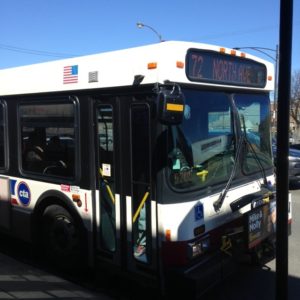
Remember payment for bus fare in Chicago can be done through a Ventra ticket or cash only (exact change needed).
NOTE: NO credit card payments and NO change from the driver on buses. If you use the new Ventra App, you can present your digital pass to the driver and get on board that way.
TIP: If you'd rather not deal with figuring out Chicago's timetables and maps, why not utilize a hop-on-hop-off bus tour? You'll get interesting commentary on the city and simple routes to keep up with.
GETTING AROUND BY WATER TAXI
Chicago's water taxi system is another convenient way to get around and includes docks close to major attractions like the Navy Pier and Museum Campus, where you can find The Field Museum, Adler Planetarium, and Shedd Aquarium.
However, the water taxis work on a separate ticket from the rest of the city's transport system.
If you're just looking for an excuse to get out on the water, why not try a riverboat tour or cruise? These fun tours provide commentary about Chicago, and some of them include meals.
Prices
One-Way Ticket: $6
All Day Pass: $10
Ten Ride Pass: $25
DIVVY BIKE SHARE SYSTEM
This is separate from the CTA and your Ventra card, but well worth mentioning when discussing how to get around the city.
If the weather is nice, you may consider using the convenient bike share system, Divvy.
There are hundreds of stations in Chicago, and you’ll find many riders on our streets!
Pricing Chart
| Single Ride | Day Pass | Year Pass | |
| Classic Bike Prices | $1 unlock + $0.18 per minute | 3 hours free + $0.18 per minute | 45 minutes free + 0.18 per minute |
| Scooter Prices | $1 unlock + $0.44 per minute | Free unlocks + $0.44 per minute | Free unlocks + $0.29 per minute |
| E-Bike Prices | $1 unlock + $0.44 per minute | Free unlocks + $0.44 per minute | Free unlocks + $0.18 per minute |
If you're a tourist, chances are only the Single Rides or Day Passes will be of any interest to you.
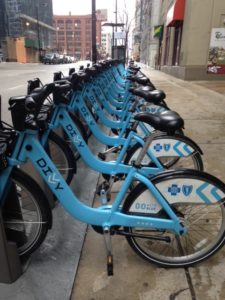
Locals might decide that a year-long pass is worth the price for free unlocks and lower prices on e-bike rentals, but these aren't really options for anyone visiting for a short time.
If you're trying to get a sense for how much it will cost per ride, here's a rough breakdown of prices per every half hour for up to 4 hours.
| Bike Rental Prices Per 30 Minute Intervals | Single Ride $1 + $0.18 per day | Day Pass $18.10 per day | Year Pass $143.90 per year |
| 30 Minute Ride | $6.40 | $0.39 | $0.01 |
| 1 Hour Ride | $11.80 | $0.78 | $2.71 |
| 1.5 Hour Ride | $17.20 | $1.18 | $8.11 |
| 2 Hour Ride | $22.60 | $1.56 | $13.51 |
| 2.5 Hour Ride | $28 | $1.95 | $18.91 |
| 3 Hour Ride | $33.40 | $2.34 | $24.31 |
| 3.5 Hour Ride | $38.80 | $41.53 | $29.71 |
| 4 Hour Ride | $44.20 | $47.32 | $35.11 |
It helps to consider the costs per the amount of time you plan to use the service, because you can really see who each plan is intended for and why each plan works the way it does.
For instance, given that the year-long pass is technically more expensive from 1-3 hours, it's clearly intended for locals using the bikes to get from one location to the next.
If you're a traveler, it's pretty clear that the day pass is the best deal, especially if you make sure to return your bike to a drop off point at least once every 3 hours.
With the day pass, it's entirely possible to simply pay $18.10 for the entire day, which is a lower cost overall for the first 3 hours than single rides.
That said, if you only use the bikes for less than 30 minutes at a time, chances are it won't be too costly. Still, we recommend using the day pass to get the most bang for your buck.
HELPFUL APPS
Here is a list of free apps we recommend for your stay in Chicago.
Navigate seamlessly through the Chicago Transit Authority's extensive network, keep updated on bus routes, or make your way around the Chicago River.
Whether you're hopping on a Chicago Water Taxi, understanding the city's grid system, or exploring suburbs and communities like Evanston, these tools are invaluable.
They ensure smooth journeys across Chicago, whatever the day of the week or the weather conditions.
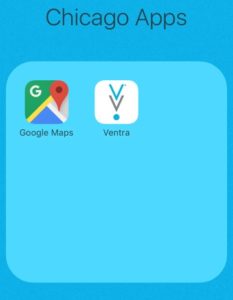
Google Maps
We recommend downloading the Google Maps app on your smartphone.
Unlike some map applications, this one tells you which bus or train line to get on, as well as the arrival/departure times and the name of your stop.
You can watch in real-time as you move toward your destination. Useful!
Ventra App
The Ventra App is free and gives you fast/easy access to “Transit Tracker” to see the up-to-the-minute schedule of CTA subway “L” trains, buses, and Metra Trains.
You can also re-load your registered Ventra Card or buy Metra tickets directly from the app.
Fares and passes can also be purchased on the Ventra App, allowing you to save time and wallet space.
As long as you have your phone, you'll never be stuck without transportation in Chicago!
Rideshare Apps
There could be times when it is much safer to use a rideshare service such as Uber of Lyft.
For instance, if it's after dark and you need to get around, it might make more sense to use one of these services.
Spothero App
It can be very difficult to find parking in Chicago, but this app makes it very easy to find the best parking spots in the city.
Even if you're just looking for a place to park so you can use public transport for the rest of your journey, this is one of the easiest ways to get the job done.
Tips From Locals and Travelers
Although we do our best to provide the information you'll need to use public transportation safely in Chicago, there's always a chance that we might miss something.
If that happens, we suggest checking our Chicago Travel Tips group on Facebook. Members of the group frequently discuss how to use Chicago public transportation and answer a variety of questions about the service.
Here are a few of the best examples of this:

Some visitors note that while they didn't trust this service before, they have since used the L and found it much easier than driving through the busy streets of Chi-town.
Other members on our group recommend that if you're still nervous, you can always ride in the first car of the train with the conductor, where there will always be someone to address any concerns.

While Chicago's transit system doesn't operate around the clock, CTA buses and trains typically run from around 4:00 AM until 1:00 AM daily.
Even if you stay out extra late, chances are you won't have too much trouble getting home!
If you're concerned about the safety of Metra trains, our group notes that there is nothing to fear.

Local users report that their experience on even the latest train of the night was entirely safe, and that you'll probably experience more problems during rush hour at Union Station!
Many users on our group recommend using this app to make traveling around the city much easier, some even indicating it's better than hop-on hop-off bus tours.

One of the members recommends this service as an excellent alternative to a river cruise, as it's much cheaper and they provide a similar service without the additional tour.
They also noted that if you do want a tour, we actually offer them for free!
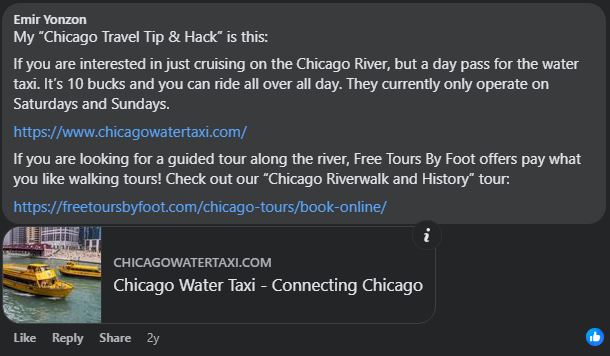
Some locals recommend using ride share services like Uber after dark, but they also note that most fears over using CTA public transport are unfounded.

If you're looking for a good parking spot, make sure to check our group first, as our members frequently offer suggestions of some of the best and most affordable places to park.

For more helpful suggestions and advice, please visit our Chicago Travel Tips Facebook Group and consider asking any question you may still have about using public transportation in the Windy City.
RELATED POSTS:
